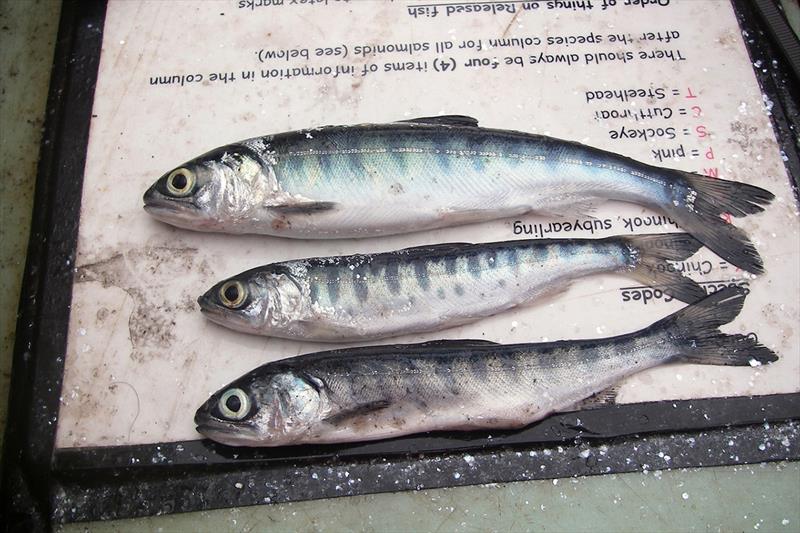
Looking back at the Blob - Chapter 2: Marine Heat Wave Intensifies, "Completely Off the Chart"
by NOAA Fisheries 10 Oct 2019 07:50 BST

Many coho salmon that went to sea during the Blob years struggled to find food, appearing thin compared to more successful fish © NOAA Fisheries
Temperatures of up to 7 degrees Fahrenheit above normal disrupted the marine ecosystem in both expected and surprising ways.
Andrew Leising is a research oceanographer at NOAA Fisheries' Southwest Fisheries Science Center (SWFSC). In 2018 he set out to answer a simple question about the unusual ocean heating of the Blob Years: How unusual was it?
"We now recognize that the Blob was an extreme example of a marine heat wave, where the ocean surface warms beyond the reach of our observations," said Toby Garfield, director of the Environmental Research Division at SWFSC. "We needed to know how it stacked up. How big was this?"
Leising developed criteria to define how big marine heat waves get, how long they last, and how intense they become. Then he searched high-resolution satellite images of the eastern Pacific Ocean since 1981. That was the year the images first became available from a new NOAA satellite that carried the advanced sensors.
The answer was stark.
"Nothing else even comes close," Leising said. The event that started off the West Coast in 2014 is "completely off the chart." It exceeded even the extent of the strongest El Niño patterns, which commonly change the weather throughout West Coast states, of the last 30 years.
"Climate Stress Test"
A separate evaluation of marine heat waves around the world developed an intensity ranking similar to that used for hurricanes. It classified the Pacific Ocean Blob as a Category III, or Severe, heat wave. During 2016, about 70 percent of the world's oceans were affected by a marine heat wave to some degree.
In the North Pacific Ocean, climate change studies suggest that heat waves will become more common, cover larger areas, and last longer.
That is why Cisco Werner, the Chief Scientist at NOAA Fisheries, views those years as a "climate stress test." They are a preview of temperatures and conditions likely to become routine as the climate warms.
Now the question he asks is: Did we pass the test?
His answer is yes, but there is still a lot to learn. Timely closures of West Coast crab and clam fisheries protected the public from the dangers of the record toxic algal bloom. Fishery disaster declarations will help mitigate the economic impacts to fishermen. However, scientists learned that they must better anticipate how changing conditions may affect protected species. They also need to improve how they get those details to fishery managers and others who need them.
First Signals of Change
One of the early signals of change emerged in 2014. Millions of salmon returning to the Fraser River in British Columbia began avoiding U.S. waters because of high ocean temperatures. Northwest U.S. tribes that rely on catching some of those fish could no longer reach them.
That prompted the first of what would become a dozen different federal fishery disaster declarations along the West Coast. They were declared for everything from sea urchins to sardines, with a dollar toll in the many millions. Scientists also documented impacts on non-commercial species such a sea stars, afflicted by wasting disease compounded by the warmer waters.
In 2014, and again in 2015, high West Coast temperatures combined with severe drought years. The combination wiped out more than 95 percent of the eggs of highly endangered Sacramento River winter run Chinook salmon. That left only one year class of fish to perpetuate the species.
The warming ocean meanwhile accelerated the metabolism of fish, demanding more energy. At the same time the influx of warmer water brought leaner plankton, and krill declined. Suddenly fish had to find more food at the very time the food web was providing less of the rich fatty lipids that help salmon and other species bulk up to better survive the ocean.
"It was a double whammy," Werner said.
The food web was starving. In the Gulf of Alaska, catches of Pacific cod nosedived as fishermen pulled up unusually skinny adult fish and few younger fish at all. In Southern California, emaciated sea lion pups washed ashore as their mothers left them for longer periods while hunting scarce food.
Toxic Algae Multiply
In early summer 2015, Washington officials shut down beach digging for razor clams. The filter-feeding shellfish collected high levels of a potent toxin produced by the marine diatom Pseudo-nitzschia. The algae are commonly present at low levels but rapidly multiplied amid the warm temperatures.
Soon closures expanded from California's Channel Islands to Alaska. This was a scale and magnitude of harmful algal bloom never encountered before on the West Coast.
High concentrations of the algal toxin, domoic acid, delayed the opening of West Coast Dungeness crab fisheries. In Alaska, meanwhile, dead whales began washing up in numbers that NOAA Fisheries declared an Unusual Mortality Event. The harmful algal bloom would later be suspected as a contributing factor.
Further south on the West Coast whales responded to the decline of krill and other deep-water forage by changing their eating habitat. They began feeding on anchovy and other species in shallower water closer to shore.
Right where many crab fishermen were about to set their traps.
Coming next: Unexpected effects conspire in increased entanglements, raising specter of further unexpected results to come